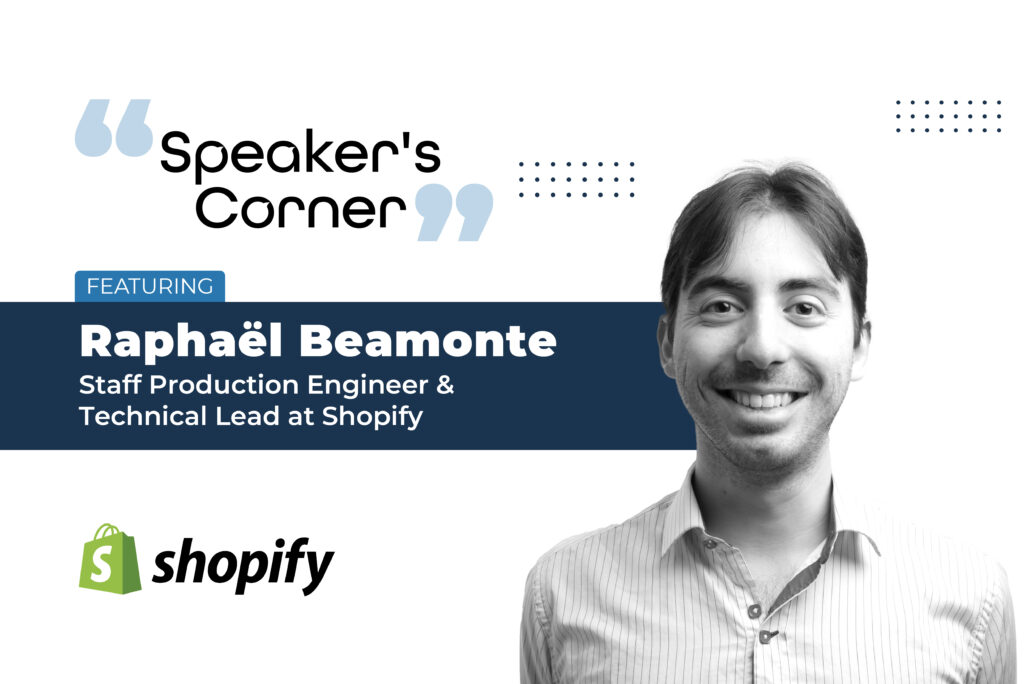
Speaker’s Corner: Featuring Raphaël Beamonte, Staff Production Engineer & Technical Lead at Shopify
After the onset of the pandemic, eCommerce platforms like Shopify have gained momentum, tell us more in terms of the features and add ons…
Shopify is an all-in-one eCommerce platform that can be used to start, run and grow a business, both online – like a website, offline – for your brick and mortar store, or on the go. In the same way that people would use platforms such as WordPress for blogging purposes, you can use Shopify if you want to build your shop. Shopify provides you with the foundation to run your business, and you provide and manage the content. As you try to get into the online selling market, you are expected to have a storefront website, showcase your products, engage with your customers, and accept payments through different means, for naming only a few. Our platform offers the tools needed to manage those activities, both online and offline for in-person sales, through a Shopify POS (Point of Sale).
At Shopify, we aim at making commerce better for everyone, and we mean it! So our eCommerce website builder has features accessible for beginners, but also more advanced ones for the specific needs of eCommerce experts. And to help you with your back-of-house tasks, Shopify provides inventory management, with support for multiple locations, and help for shipping and fulfillment of orders. Our platform integrates with many sales channels, so you can convert your followers into customers. And for what Shopify does not directly provide, you might find your happiness with one of the many applications that are offered in our app store. And all of that while we take care of scaling up our platform for you and your business and making it as resilient and secure as possible.
We’re building a 100-year company, and we still have “a few” years to get there. We won’t get there without the merchants that use our platform, their customers that allow them to grow, and that allows Shopify to grow with them. So we keep really merchant-focused on our choices of where the company is going, and what are the next problems to solve.
My team handles Shopify’s traffic, and we try to keep things as fast, stable, reliable, and safe as possible for people using the platform. We keep moving in that direction with a mix of solving the little problems of every day and building the next big change that will improve the platform in a bigger way.
What are the challenges you come across today?
Maintaining the reliability, performance, growth, and stability of an eCommerce platform is a non-stop challenge because it’s highly dependent on buying and selling behaviors. For example, on top of the usual sales, a business may want to increase its traffic by offering exclusive deals, limited-time offers, or launching a new product. As an eCommerce platform, you need to be able to provide a service that won’t slow down or break during those peak traffic times.
If your platform ceases to work during a sale, your merchants lose out financially, their brand is hurt, and the trust between you and their business is damaged. Another challenge is the flexibility of a platform. A merchant shouldn’t have to switch platforms because their business has grown. They want a platform that will grow and evolve with their brand. That’s why merchants want a platform that provides a large number of applications to satisfy the needs of their business and allow them to change as their brand changes. You also want access to personalize the experience more and more to your shop and customers. So you will want to choose a platform that not only allows you to grow with them but to grow in the way that makes sense for you.
I can see also the challenge of globalization, because your customer base does not have to be local, and you might have to deal with the internationalization of your website and customer experience to what works best in their locality. You might also have to deal with global deliveries and fulfillment. You will want a platform that helps you with that too.
And one thing that all of those have in common is that they’re all things that Shopify keeps a close eye on. They’re part of what our platform provides to merchants, either through the usual offering or Shopify Plus, in order to accompany them in their journey as an entrepreneur or big brands.
How has the COVID-19 pandemic changed the way you go about business? What trends do you see for the future…
The COVID-19 pandemic definitely pushed the eCommerce industry forward. While brick-and-mortar businesses struggled, it led merchants to find alternative solutions, which eCommerce offered. At Shopify, knowing that those merchants were in a difficult situation, we tried our best to reduce the toil of making the online switch by offering trial periods of 9 months. We also felt the difficulties of shops used to serve their local communities and using Shopify POS (Points of Sale), and very quickly reacted by adding curbside pickup options at the checkout. Our reactions to that worldwide event led to more people using our platform to be able to continue earning a living, and of course to more shops opening their virtual doors.
On the consumer side of things, we definitely saw the traffic to our platform increase to a level way ahead of our projections. We adapted, scaled up our platform, and made sure we were able to sustain the level of traffic we were getting. This was challenging, but the interesting kind: you rarely expect to see that kind of “sudden” scale happening in a well-established company, but at the same time it is not that surprising for a company like Shopify.
As to what the future entails, I do not think things will trend down. The merchants that made the move to eCommerce will continue to reap the advantages it brought them, and people will keep ordering online because it is convenient, and with way more people working from home regularly, it is easier to not miss deliveries. I just hope that merchants and consumers will put forward platforms that compensate for carbon emissions like Shopify does, as we still need to protect our environment.
As a technical lead at Shopify, could you explain to us your daily work process?
Every day is its own story! I really see two aspects to my technical lead role: the technical side, but also the people side.
My job is to identify the pain points or missing pieces of our infrastructure that we could build to solve problems, improve performance or simply make our jobs easier. I work with the people manager of the team and our leadership to establish a technical vision that makes sense for where Shopify wants to get to, and then I make sure that the work we do and the projects we end up tackling bring us closer to that vision.
I also have sort of a cross-team job as I have to keep close to a number of other teams and keep updated context on what they do and suggest when my team should get involved. I also am the point of contact for a number of vendors Shopify is working with. Finally, I lead a number of cross-teams company-wide projects and am a technical stakeholder on a number of others.
On the people side, I try to take a mentor role and grow the people in my scope of influence – which, at the same time, grows me. I try to make sure that the people in my team or projects work on things that keep their interest sharp and satisfy their career objectives and where they’d like to get to. I look for opportunities for them, delegate some of my responsibilities when it makes sense, and rely on them as much as I can while letting them know that I’m there for help.
What is your biggest objective as a speaker?
Every company and every infrastructure are different and have its own challenges, but one of the nice things about engineering is reusing ideas. If what I share when speaking can help in sparking new ideas of solving infrastructure problems people have been having or simply helping them figure out that some technologies or ways to use those could solve some of their problems, then it’s a win.
I believe sharing knowledge is strengthening others with the right tools to keep the world moving forward, and when the world moves forward we’re all winning. We get smarter from each other’s experiences, and I hope I’m just another link of that chain, contributing to the extent I can.
Could you share with us the points of discussion (the input that you provided) during the panel(s) at Dash 2021?
I was part of a panel titled “Engineering for Reliability: Scaling Safely in the Cloud”. Among other topics, we talked about what reliability means, how and when to scale your systems, and how security relates to reliability.
The experience I brought in is deeply related to what I’ve been able to live with my Shopify journey of about 3 years now, which is at the same time short and long given what we lived in the last few years, and how the platform has evolved and grown. I’ve seen and participated in scaling Shopify for more than a million merchants, and all the challenges around that. I’ve seen applications for specific use cases becoming the norm for the platform and having to serve a lot of traffic. And that definitely gives me opinions on how to best proceed, even if these views keep evolving as I learn and grow myself.
One thing that I put forward during the panel is the importance of security: everything is about the trust of the people using your platform and products. You can have a drawback in trust when your services are down for a period of time, but data leaks and security breaches are much harder to come back from. Once the data’s out there, you cannot pull it back. It’s important to keep that in mind when designing your systems and services, and when scaling them up and adding exposure to external breaches.
As a leader, what are the factors both professional and personal that drive you? What keeps you going?
Learning! I love the opportunities that this role gives me: I’m learning technically, and I’m learning about people and from people. I believe that when you have the opportunity, working somewhere you can learn is always going to be a net positive experience, because you’ll finish your days with new knowledge. Being in a leadership position allows me to balance the technical problems and the infrastructure challenges, with the mentoring and growth of people.
In your opinion, do digital events give you a similar level of feedback/result vis-à-vis the live versions? What would you say were the biggest pros and cons of both formats? Which do you prefer?
Watching conferences and panels on streaming platforms is more and more common, even years after it has been given. What I like about virtual events is that they level the access to the conference content, even for people that wouldn’t have had the possibility to attend otherwise. However, it is definitely harder to connect with the audience and see if your tone and expressions are catching their attention or if you need to adjust. But then again, when you see live streaming platforms, there are ways to adapt your content to be more interactive, even with an audience that’s hidden from you!
As to which I prefer… I would lean toward the in-person, if only because networking with people and visiting places are things difficult to reproduce virtually. Hybrid events might bring the best of both worlds, with in-person activities but keeping open the participation of people that can’t travel.
Eventible has recently launched a B2B Interactive in Person Event Tracker – the tracker shows you in-person events going live in various parts of the world. Do you think this is useful?
This is nice to see the in-person events resuming around the world, reassuring of the evolution of things.
Eventible.com is a review platform catering to B2B events. Given how review-driven our lives have become today, do you think reviews will bring in a level of transparency to the events industry? Would you rely on event reviews from other speakers if you had to make a speaking decision?
Reviews are important but need to be taken carefully! They might be interesting for less-known events, and they might help those events secure speakers that would be hesitant in general when being reached out to by an event that’s less known. However, I can also see the downside of people more often sharing their unhappiness on the reviews platform, which could lead to biased images of the events, so this would be something to be careful about.
Finally, do you have a favorite mocktail or drink? We’d be delighted to know.
Amaretto sour for the fancy days, Gin tonic for the usual.
About Raphaël: Raphaël is a Staff Production Engineer and the tech lead of the Traffic team at Shopify, taking care of the interfaces between Shopify and the outside world, and providing reliable and scalable systems for configuring the edge of the neverendingly growing applications. He holds a Ph.D. in Computer Engineering in systems performance analysis and tracing, and sometimes gives lectures to future engineers, at Polytechnique Montréal, about Distributed Systems and Cloud Computing.
To view Dash 2021 on Eventible, click here. To write a review, click here.




Comments are closed.